(January 1931, 20m) Director: William C. McGann Released: Paramount Pictures, April 4, 1931 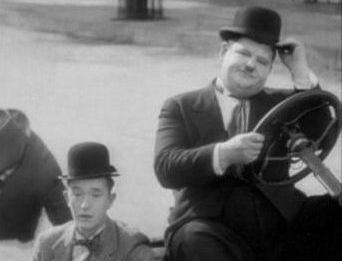 As with The Hollywood Revue of 1929 and the later Hollywood Party, Stan and Ollie were quite adept at getting a brief cameo in a 'star' studded film and then stealing it. Here they appear for less than a minute, yet manage effortlessly to put in the funniest segment of the short. Unlike the other two mentioned films, this one does actually contain some genuine stars, including Douglas Fairbanks Jr., Buster Keaton, Barbara Stanwyck, Joan Crawford, Gary Cooper, Fay Wray, Edward G. Robinson and Maurice Chevalier. Produced by the Masquers Club of Hollywood for the National Variety Artists Tuberculosis Sanitarium, all concerned gave their time free, and the free distribution of the movie would see collections taken after each screening for the charity. As it's a charity piece then it's hard to be unkind to this loose collection of cameos, but it can drag a little, and most of the non-L & H comedy sequences haven't aged well. Interestingly it was released into cinemas on the same day as their next film, Laughing Gravy.   (January/February 1931, 20/31m) Director: James Horne Released: MGM, April 4, 1931 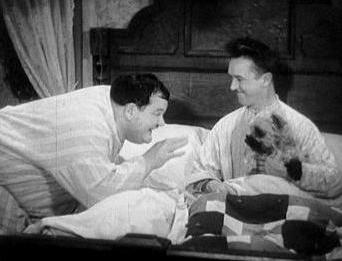 A remake of their final silent, Angora Love, this time with a dog, the Laughing Gravy of the title, instead of a goat. Laughing Gravy himself was actually a female dog that produced offspring owned by Charlie Hall, the dog-hating landlord. A particular 'goof' can be witnessed in the film during the rooftop sequences, where Laughing Gravy can be seen in many differing locations between edits, often appearing to teleport between takes; to say nothing of Charlie Hall smashing one of his plant pots only for it to reappear on his windowsill at the end. Though a straight remake of Angora Love, the film has much in common with Below Zero, taking the previous year's tale of snow-bound desolation and placing Stan and Ollie within it. However, in stark relation to both those movies, Laughing Gravy has a more self-consciously 'cutesy' humour not seen before in a Laurel and Hardy film. The goat in Angora Love provoked comic reactions due to its absurdity, whereas all the eponymous Laughing Gravy can do is provoke the sympathy of an audience that loves cute animals. This marked shift in Stan and Ollie's comic intentions can be seen when the idea was used a third time a year later for The Chimp. There the titular animal is clearly a man dressed up in a suit, and the laughs pitched towards the very young. When Laurel and Hardy made Angora Love in 1929 they were renting a room in a house where sailors and prostitutes roamed the hallways. Pitch forward to 1934 and this clear line towards a broader audience sees them in Babes In Toyland, a musical fantasy for children. The theatrical release of Laughing Gravy ended with Charlie Hall, at the end of his tether with all that he's experienced, committing suicide. A third reel alternate ending featuring Stan receiving an inheritance was rejected for the English market but left in the foreign language versions. After long being lost the English version of the third reel was eventually found in 1985 and the option of both takes is available on DVD releases. In both resolutions the hand of the writer is clearly felt, though this makes it no less valid as comedy. The version familiar for decades sees a policeman come in out of the cold and inform Charlie Hall that he'll have to spend two more months with the boys as the house has been quarantined due to a smallpox outbreak. The third reel take has a reprise of the 'Stan's Uncle leaves him an inheritance' theme from The Laurel-Hardy Murder Case, with Stan receiving a cheque for $1000, providing he severs all ties with Hardy. After four years together as the 'Stan and Ollie' characters, this sweetly-acted coda takes time to explore the relationship between the two friends. Though Stan's ultimate betrayal of Ollie is bittersweet - he only rips up the cheque so he can keep Laughing Gravy - the emotion between the two is bonus for real aficionados. In particular, Hardy's pomp-filled pretence of not wanting to see Stan's letter is wonderfully portrayed, and his genuine hurt that Stan would leave him is palpable. Perhaps the biggest contrivance associated with Laughing Gravy is that, as the final film to be reshot in foreign languages, the Spanish and French editions combined the storyline with that of Be Big!, the plot being that the characters become poor as a result of the former. While essentially the same characterisation in all of their films, Stan and Ollie go from being poor to being well off, to being bachelors and to having a multitude of different wives. This was the only attempt to reconcile two of these variances in an interesting experiment for the foreign markets. The discarding of the foreign language versions perhaps couldn't have come at a better time... as the relationship between the two leads became more complex and verbal having to perform it in phonetic Spanish and French was becoming ever more taxing and at times throughout this last attempt then both stars can clearly be seen looking off-screen for their next lines.    (February/March 1931, 20m) Director: James Horne Released: MGM, May 16, 1931 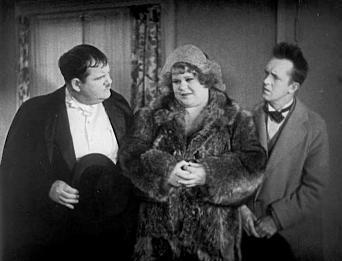 The film that makes you wish that Babe London had done more work with the boys. The actress had worked with Stan before on solo films The Weak-End Party and The Handy Man in 1922 and 1923 respectively, but this was her first time with Hardy (two Babes on the same picture?) and her only Laurel and Hardy movie. Home movie footage of her and Stan enjoying some old Laurel and Hardy movies in the 1950s can be found out there, and it's superbly charming to see. Also a standout is Blanche Payson as the brilliantly bad-tempered wife of the justice of the peace. Payson had more experience with the boys, appearing in solo Ollie short Should Men Walk Home? and solo Stan shorts Bears and Bad Men and Half A Man; as well as Laurel and Hardy movies Below Zero and Helpmates. This is my favourite appearance though, and some wonderful slapstick: by the end of the film everyone involved has reached the end of their patience with Stan, and Payson, being able to take no more, decides to silence him by punching him in the face. As always, a hilarious sound effect adds much to this comedy of simplistic violence, one of my favourite Laurel and Hardy moments of all time. The climax of the film sees a quite meaningful resolution to events as Ben Turpin , the cross-eyed JP, accidentally marries Stan and Ollie to each other. The laughs generated by playing with traditional marriage conventions are milked by Turpin 'kissing the bride'... who turns out to be Ollie. After a brief cry, Stan beckons Ollie to leave the house with him, perfectly accepting of their unplanned fate.     (May 1931, 20m) Director: James Horne Released: MGM, September 19, 1931 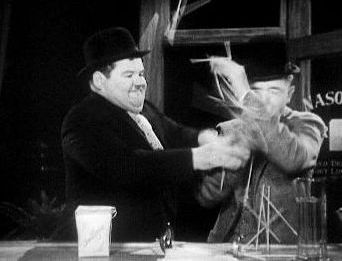 Come Clean treads familiar territory for a Laurel and Hardy short, yet also presents a remarkable economy in its use of comedy. The basic set up - Stan and Ollie rescue a psychotic female criminal from committing suicide, but are terrified their wives won't believe in their innocent intentions when the criminal follows them back to Ollie's home - is a reworking of themes from their very first sound picture, and others. There's also the reuse of the gag with Stan passing a note under the door that gets snatched by a pretending-to-be-out Ollie, last seen in Should Married Men Go Home?, not to mention the reappearance of the mystical '$1000 reward from out of nowhere' resolution to Stan's troubles. Yet in amongst this is some fresh new material, which not only didn't get reworked for later films, but also doesn't get overdone here. There's a scene with Stan and Ollie failing to take elevators together, and more significantly there's a scene where Stan tries to order non-existent ice cream flavours off vendor Charlie Hall. Whereas in other entries this scene would be milked for maximum comic value, here it's over and done with, with not a second wasted. Two very unusual scenes include Hardy telling his wife about his fantasy of hitting her (before being punched himself) and the final resolution, which sees Stan disappear, unseen, down the bath plughole. You do have to question how much effect the material sometimes had on the stars during the shooting of these films, particularly Ollie. Around this time, with Myrtle's alcoholism increasing, he had become involved with a woman known as Voila Morse. Even though he's innocent of an affair in his movie life, having his onscreen wife calling him 'Poppa' (with Myrtle he was known as 'Daddy') and accusing him of infidelity it's a little close to home. Then there's his failure to save someone from drowning - Stan has to do it - something that, in reality, haunted him when he couldn't save his halfbrother Sam from a similar fate in 1909. Although Ollie rescued Sam from drowning in the Oconee River, he died from the injuries shortly afterwards.     (May/June 1931, 20m) Director: James W. Horne Released: MGM, October 31, 1931 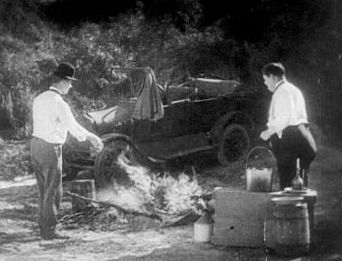 One of the lesser-seen sound shorts, One Good Turn was reputedly suggested by Stan to appease his young daughter who had grown frightened of Oliver Hardy after watching him bully her dad on screen. The machinations the plot has to go through in order to get Stan to uncharacteristically beat up Hardy are many, and the short turns its back on previous Laurel and Hardy relationships by making Hardy mistrust his friend. Amusing, but a lesser short.    (September 1931, 37m) Director: James Horne Released: MGM, December 12, 1931 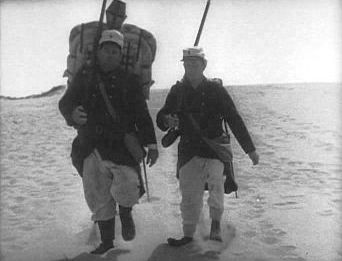 When friction between Stan and Hal Roach began to develop in the mid 30s it caused a souring of the relationship that makes it easy to overlook just how much Roach did for the team. Whatever problems Stan and Hal may have later had, one thing Roach wasn't was a man who put profit above his art, with Beau Hunks as exhibit number one. A four-reeler because Roach didn't want to edit out any more material, Beau Hunks was still sold for the same rate as a two-reeler, meaning Hal Roach studios were essentially giving away 50% of the film for free. Some may suggest that those extra two reels don't add a lot to the quality of the film in the final event: seeing the director in blackface playing a Muslim warlord or watching Stan throwing tacks into someone's eyes with malicious (albeit self defence) intent isn't necessarily all that amusing, or comfortable in today's climate. Yet what makes the second half such a striking dip is that the first half is among the very best that Laurel and Hardy had to offer. Often known for their slapstick, here the dialogue is its very equal. Hardy here is a man that combines stupidity with pomposity to such a degree that he thinks calling the Commandant of the French Foreign Legion 'Brigadier' and 'Admiral' is ingratiating himself. Listen out too for great exchanges like 'Well, you certainly are a sorry-looking pair!' 'We're not sorry.' 'No, sir, we're just discouraged.' Alfred Hitchcock often talked about using suspense for horror... rather than surprising an audience with a twist, allowing an audience to know a fate is about to befall the hero or heroine, but the intrigue being exactly when. Laurel and Hardy often use the concept of suspense for humour, and so here when we see a spring stuck in Ollie's trousers without his knowledge, we know that it's going to cause chaos, and having the joke signposted only serves to make it funnier. An in-joke is that the photo of lost love 'Jeanie-Weenie' is, of course, Jean Harlow, the actress who had appeared in three silent Laurel and Hardy shorts. By this stage Harlow was a massive star and had just appeared in Goldie as the film was being made. When Beau Hunks was released Harlow was an even bigger star, having then appeared in Frank Capra's Platinum Blonde. There are some small errors, such as the distance between Stan and Ollie's beds changing between shots, or a conversation between the duo and the Captain breaking the 1800 line rule, but there's also a sophistication in the way many of the images are put together. With directing considerably above standard for the team, there's also title cards overlaid on top of the action, wipes between scenes (as also seen in One Good Turn, and a regular fixture from this stage on) and the suspicion that it was maybe really intended as a four-reeler all along. Certainly the production has a lot more polish than usual, despite flagged errors, and there's a real solid feel to it all. While Beau Hunks doesn't quite live up to the promise of its first half, taken as a whole it's still a very fine entry indeed. In August, shortly before making Beau Hunks, Stan officially changed his surname to Laurel. Although he had been using the name professionally since 1918, his legal name was still Jefferson at this stage. When asked about the name many years later Stan claimed not to have any recollection of where 'Laurel' came from, other than being a shorter name to fit on movie posters. However in the 1960s, Mae, Stan's common law wife from 1917-1926, revealed to author John McCabe her recollection that Stan had been superstitious of his real name containing thirteen letters and took the 'Laurel' from laurel leaves.     (September 1931, 20m) Director: Hal Roach Released: MGM, December 26, 1931 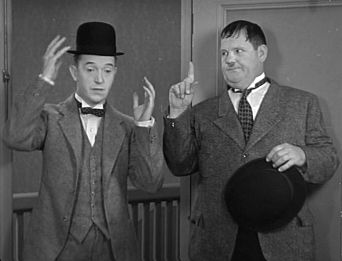 In March 1931 Hal Roach began producing the first in a series of shorts for a new female double act he'd put together, Zasu Pitts and Thelma Todd. Altogether Roach made 17 shorts with the team, and, when Pitts left his studios, he made a further 21 shorts teaming Todd with Patsy Kelly. On The Loose was the sixth in the Pitts-Todd series, and Roach got Laurel and Hardy to put in an uncredited cameo appearance in order to help the range. Thelma Todd had already appeared with Laurel and Hardy in the shorts Unaccustomed As We Are, Another Fine Mess and Chickens Come Home-, and would go on to guest star with them in the features Fra Diavolo and The Bohemian Girl. Also appearing uncredited was Charlie Hall as a fairground attendant. The short itself is reasonably diverting, but on the evidence of this then a new Laurel and Hardy they weren't.    (October 1931, 20m) Director: James Parrott Released: MGM, January 23, 1932 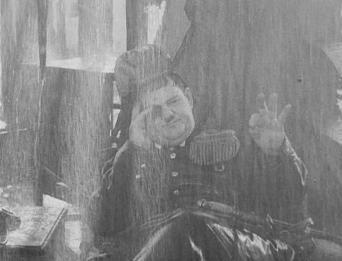 In 1984 Helpmates was the first Laurel and Hardy film to be reproduced in computer colour, in an attempt to introduce the films to modern audiences. A controversial means of repackaging the films, computer colour (otherwise known as 'colorization') was soon transferred to almost all of the Laurel and Hardy sound films produced for Hal Roach. One of the problems with the colorized versions is that the materials they used to create the versions from aren't as high quality as the traditional film prints. The sound and image aren't as clear, the edges of the frame are often cropped, and there are edits in the source. In Helpmates the opening scene which opens with a tracking shot into Ollie's trashed house is replaced with still shots. Another issue is that, in most cases, the colorization simply isn't very good, certainly by modern standards, and that what was something of a technological marvel in the mid 1980s looks washed out and ineffective twenty five years later. Anyway, Helpmates itself is possibly a top five short for me, or as near as can be. There's an oddly surreal moment where Stan appears at Ollie's door fully dressed after being on the phone to him in his night clothes just seconds earlier, and it ends with possibly their greatest-ever ending. Hardy never got involved in the creative process and saw himself as a jobbing actor, but reputedly never required any direction. A lot of this is due to the fact that the 'Ollie' character pretty much was him, just with the gestures exaggerated and the intelligence downsized, making it all the more naturalistic. However, one of the few suggestions Hardy was rumoured to have made came here, as he sits, battered and trashed in the burning remnants of his home, the rain pouring down upon him... and he decides to pick a piece of lint off his trousers. Such an amazing understanding of character. Two superb moments also surround this. One is the team's tradition of 'taking it big', a phrase they used in scripts to indicate a massive double take at events or surroundings. The fact that Hardy walks into his home and finds it burned to the ground but still has to do an enormous double-take before he can acknowledge it, is the extreme epitome of this humorous over-reaction. Coupled with this is, after Stan's funniest-ever crying scene, the underplayed acceptance of both men, resigned to their fate as being locked in a destructive relationship from which they can never escape: 'Well, I guess there's nothing else I can do.' 'No, I guess not.' 'Well, I'll be seeing you.' 'Goodbye.'     (November 1931, 20m) Director: James Horne Released: MGM, March 5, 1932 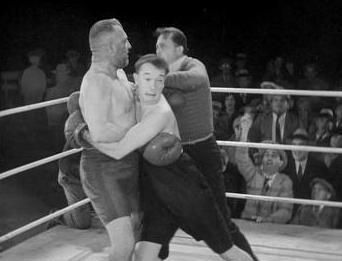 Any Old Port! is an unusually bleak Laurel and Hardy movie. All the signs are there that they tried to recreate some of the old magic - there's the guestbook writing scene reworked from Double Whoopee and a boxing match just like in Battle of the Century. They even brought back Walter Long, who was so amusing in Pardon Us. However, here not only is Long cast as a man who tries to force a woman to marry him and throws her to the floor, but Stan and Ollie are the men who try to walk out and leave her to her fate when they release how tough he is. Adding to this are some violent and stiffly staged sequences including a judge getting scalped with a fan and poor continuity like Long's hat appearing on his head between takes. While not an awful film, Any Old Port! feels more like a drama as the threat of Long is so seriously presented, and it's hard to generate laughs from a man who threatens women. An opening reel on board a ship with James Finlayson, Tiny Sandford and an ostrich was known to have been filmed but dropped after previews. Sadly, footage no longer exists from this sequence, with a new reel filmed to end the short. This final reel features Stan in a boxing match in the film's funniest half, with Laurel's miming of an illegally weighted glove particularly striking.    (December 1931, 29m) Director: James Parrott Released: MGM, April 16, 1932 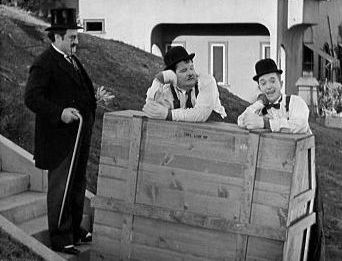 One of Laurel and Hardy's most famous films, The Music Box is also the most acclaimed, winning an Oscar for best short subject. While the film deserves a lot of the goodwill directed towards it over the years, its 'anything for a laugh' mentality does lead one to question the logic behind it at times, even if it is just a comedy. While the thought of Stan and Ollie taking a piano up some stairs, getting it all the way to the top, then taking it back down again when told there was an easier way to do it is funny, you have to ask yourself are even Laurel and Hardy that dumb? Other oddities include a sequence where Stan kicks a woman and the 'piano' landing in a pond, visibly floating. And while essentially a remake of Hats Off, it must also be noted that the 'piano unsuccessfully up some stairs' routine was done before, complete with pond, donkey and cart, by Charlie Chaplin in 1914's His Musical Career. However, despite being famous for the piano and the steps, the piano only actually falls down them three times (as mentioned, they voluntarily take it back down for a fourth) and the piano is delivered halfway through the movie. What then follows is the remainder of this three-reeler whereby Stan and Ollie unwittingly wreck the house to which they're delivering the piano to. The Music Box is notable for existing in a format without incidental music in a film series where the shorts were repackaged with almost wall-to-wall sound extracted from the features. While this does make the pacing of The Music Box seem different to many other Laurel and Hardy pictures, the diagetic music is strong. Not only do we get the distorted chimes of the piano as it crashes down the steps but we get a superb sequence where both Stan and Ollie perform a Dixieland tap dance. This particular scene actually embodies their relationship perfectly, in that while they attempt to clean up the house they both pick up rubbish and transport it to the opposite end of the room, constantly replenishing each other's supply of waste.   
|
||||||||||||||||||||||||||||||||||||||||||||||||||||||||||||||||||||||||